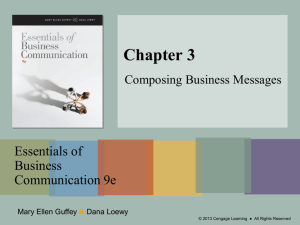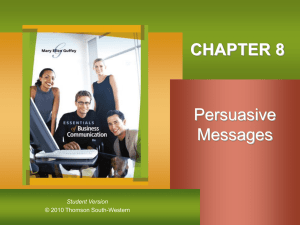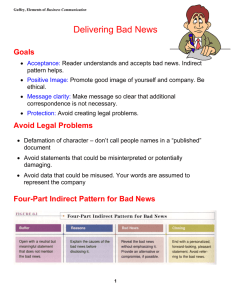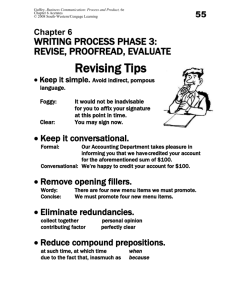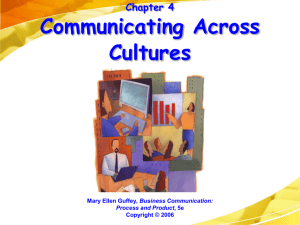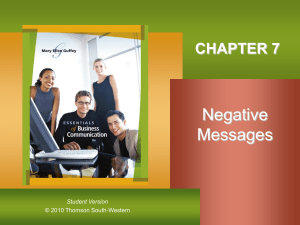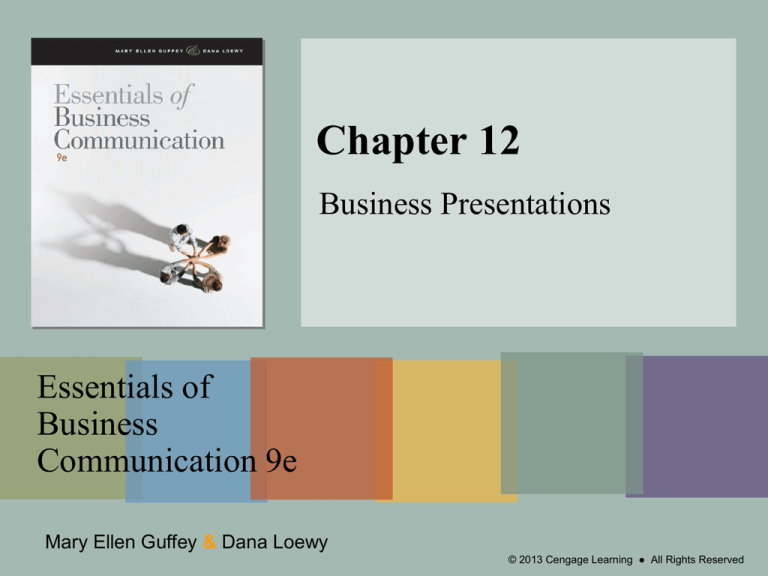
Chapter 12
Business Presentations
Essentials of
Business
Communication 9e
Mary Ellen Guffey & Dana Loewy
© 2013 Cengage Learning ● All Rights Reserved
Oral Presentations: Preparation
Know your purpose. Know your audience.
© 2013 Cengage Learning ● All Rights Reserved
What do you want your
audience to believe,
remember, or do when you
finish?
Aim all parts of your talk
toward your purpose.
Friendly, neutral, uninterested,
hostile?
How to gain credibility?
How to relate this information to
their needs?
How to make them remember
your main points?
Mary Ellen Guffey & Dana Loewy, Essentials of Business Communication, 9th Edition
Chapter 12, Slide 2
Oral Presentations: Organization
The Introduction
© 2013 Cengage Learning ● All Rights Reserved
Capture listeners’ attention
and get them involved.
Identify yourself and
establish your credibility.
Preview your main points.
Mary Ellen Guffey & Dana Loewy, Essentials of Business Communication, 9th Edition
Chapter 12, Slide 3
Oral Presentations: Organization
The Body
© 2013 Cengage Learning ● All Rights Reserved
Develop two to four main points. Streamline your topic and
summarize its principal parts.
Support your main points.
Arrange the points logically by a pattern.
Prepare transitions to guide the audience.
Prepare transitions as “bridge” statements between major
points (I’ve just discussed three reasons for X; now I want
to move to Y).
Include verbal signposts.
Keep your audience interested and involved throughout the
presentation.
Mary Ellen Guffey & Dana Loewy, Essentials of Business Communication, 9th Edition
Chapter 12, Slide 4
Oral Presentations: Organization
The Conclusion
© 2013 Cengage Learning ● All Rights Reserved
Summarize your main themes.
Leave the audience with a
specific and memorable take-away.
Include a statement that allows
you to depart the podium
gracefully and leaves a
lasting impression.
Be prepared to answer
questions.
Mary Ellen Guffey & Dana Loewy, Essentials of Business Communication, 9th Edition
Chapter 12, Slide 5
Handling Audience Questions
© 2013 Cengage Learning ● All Rights Reserved
Tell audience in the beginning of your presentation that you’ll
be taking questions at the end.
Pause at the end of your conclusion before asking for
questions.
Keep control.
Call on audience members.
Repeat each question before
answering.
Direct answers to the entire
audience, not just the person
who asked the question.
If you don’t know an answer, admit it
and offer to find the answer later.
Follow up!
Mary Ellen Guffey & Dana Loewy, Essentials of Business Communication, 9th Edition
Chapter 12, Slide 6
Oral Presentations: Rapport
Analogies
© 2013 Cengage Learning ● All Rights Reserved
Worst- and
best-case
scenarios
Metaphors
Building Audience
Rapport with
Effective Imagery
Personalized
statistics
Similes
Personal
anecdotes
Mary Ellen Guffey & Dana Loewy, Essentials of Business Communication, 9th Edition
Chapter 12, Slide 7
Oral Presentations: Rapport
Sending Positive Nonverbal Messages
© 2013 Cengage Learning ● All Rights Reserved
Look professional.
Animate your body.
Speak extemporaneously.
Punctuate your words.
Use appropriate eye contact.
Get out from behind the podium.
Vary your facial expressions.
Mary Ellen Guffey & Dana Loewy, Essentials of Business Communication, 9th Edition
Chapter 12, Slide 8
Oral Presentations: Visual Aids
Multimedia
slides
Objects
for
demonstration
Transparencies
© 2013 Cengage Learning ● All Rights Reserved
Enhancing
Presentations
With Visual
Aids
Video
Handouts
Flipcharts
or
whiteboards
Mary Ellen Guffey & Dana Loewy, Essentials of Business Communication, 9th Edition
Chapter 12, Slide 9
Selecting the Medium
© 2013 Cengage Learning ● All Rights Reserved
Consider the size
of the audience
and the degree of
formality desired.
Consider cost,
ease of
preparation, and
potential
effectiveness.
Mary Ellen Guffey & Dana Loewy, Essentials of Business Communication, 9th Edition
Chapter 12, Slide 10
Highlighting Main Ideas
© 2013 Cengage Learning ● All Rights Reserved
Focus on major concepts only.
Avoid overkill. Showing too many graphics
reduces effectiveness.
Keep all visuals simple.
Make sure visuals add
something of value to
the presentation.
Mary Ellen Guffey & Dana Loewy, Essentials of Business Communication, 9th Edition
Chapter 12, Slide 11
Ensuring Visibility
© 2013 Cengage Learning ● All Rights Reserved
Use large type for slides
and transparencies.
Position the screen high
enough to be seen.
Don’t include too much
information on visual.
Be sure all audience
members will be able
to see.
Mary Ellen Guffey & Dana Loewy, Essentials of Business Communication, 9th Edition
Chapter 12, Slide 12
Enhancing Comprehension
© 2013 Cengage Learning ● All Rights Reserved
Make sure you’re on the right visual.
Don’t rush through visuals too quickly; make
sure audience has enough time to digest
each slide.
Paraphrase its verbal message; don’t read it.
Elaborate on each bullet point. Give your
audience more than the slides provide.
Proofread all visuals carefully.
Mary Ellen Guffey & Dana Loewy, Essentials of Business Communication, 9th Edition
Chapter 12, Slide 13
Practicing the Use of Visual Aids
© 2013 Cengage Learning ● All Rights Reserved
Rehearse your talk, perfecting your handling
of the visual aids.
Practice talking to the audience and not to
the visual.
Test equipment in
advance.
Have a Plan B!
Mary Ellen Guffey & Dana Loewy, Essentials of Business Communication, 9th Edition
Chapter 12, Slide 14
Oral Presentations: Delivery
Delivery Method
© 2013 Cengage Learning ● All Rights Reserved
If you are using a slideshow, practice
thoroughly so that you can speak
extemporaneously without notes.
If you are speaking without a slideshow,
use notes but try to talk to the audience
conversationally.
Beware of reading from your notes:
BORING!
Mary Ellen Guffey & Dana Loewy, Essentials of Business Communication, 9th Edition
Chapter 12, Slide 15
Combating Stage Fright
© 2013 Cengage Learning ● All Rights Reserved
Select a familiar, relevant topic.
Prepare 150 percent.
Use positive self-talk.
Convert your fear into anticipation and enthusiasm.
Take a sip of water if your throat is dry.
Shift the focus from yourself to your visual aids.
Realize that it’s okay to make an
occasional mistake.
Ignore stumbles. Don’t apologize—
just keep going.
Don't tell the audience that you're nervous.
Feel proud when you finish.
Reward yourself.
Mary Ellen Guffey & Dana Loewy, Essentials of Business Communication, 9th Edition
Chapter 12, Slide 16
Practicing Your Presentation
© 2013 Cengage Learning ● All Rights Reserved
Begin by reading your presentation aloud.
Deliver the presentation in front of a mirror using your notes
and wearing your presentation outfit.
Deliver the presentation to a friend using your notes.
Practice in front of a small group using your notes.
Ask for honest feedback.
Record or videotape yourself.
Time yourself.
Mary Ellen Guffey & Dana Loewy, Essentials of Business Communication, 9th Edition
Chapter 12, Slide 17
Putting It All Together
Before
© 2013 Cengage Learning ● All Rights Reserved
During
After
Prepare thoroughly.
Rehearse repeatedly.
Time yourself.
Dress professionally.
Check the room.
Greet members of the audience.
Practice stress reduction.
Mary Ellen Guffey & Dana Loewy, Essentials of Business Communication, 9th Edition
Chapter 12, Slide 18
Putting It All Together
Before
© 2013 Cengage Learning ● All Rights Reserved
During
After
Begin with a pause.
Present your first sentence from memory.
Maintain eye contact.
Control your voice and vocabulary.
Skip the apologies.
Put the brakes on.
Mary Ellen Guffey & Dana Loewy, Essentials of Business Communication, 9th Edition
Chapter 12, Slide 19
Putting It All Together
Before
© 2013 Cengage Learning ● All Rights Reserved
During
After
Incorporate pauses when appropriate.
Move naturally.
Use visual aids effectively.
Avoid digression.
Summarize your main points.
Show enthusiasm for your topic.
Mary Ellen Guffey & Dana Loewy, Essentials of Business Communication, 9th Edition
Chapter 12, Slide 20
Putting It All Together
Before
© 2013 Cengage Learning ● All Rights Reserved
During
After
Distribute handouts.
Encourage questions.
Repeat questions.
Keep control.
Reinforce your main points.
Avoid Yes, but answers.
End with a summary and appreciation.
Mary Ellen Guffey & Dana Loewy, Essentials of Business Communication, 9th Edition
Chapter 12, Slide 21
END
Essentials of
Business
Communication 9e
Mary Ellen Guffey & Dana Loewy
© 2013 Cengage Learning ● All Rights Reserved



